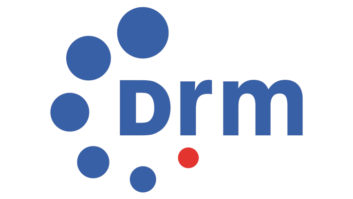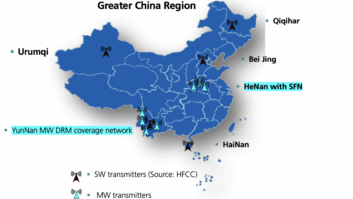The author is chairman of the DRM Consortium. Her commentaries appear regularly at radioworld.com.
Introduction — Why simulcasting?
DRM is the perfect radio solution to introduce digital radio services complementing the existing analogue services in all the broadcast bands (SW, MW, VHF band I, II and III).
DRM allows radio stations to broadcast both analogue and digital signals simultaneously, which leverages the existing FM or AM spectrum to deliver enhanced audio quality and additional services without disrupting the existing analogue broadcasts. This seamless integration enables broadcasters to offer digital services while maintaining their analogue offerings. It makes the transition smoother and cost-effective, while maintaining and enhancing the number of listeners to a particular radio station or program/channel.
Listeners with traditional analogue radios can continue to receive the legacy broadcast without any change, while those with DRM digital receivers (which also include analogue capability) can enjoy the enhanced digital services in addition.
This smooth transition is crucial for widespread adoption, as it does not alienate the existing audience base.
Simulcast Broadcasting in the FM band (VHF band II)
In the FM band (VHF band II), 200 kHz bandwidth is allocated/used by every broadcaster for an analogue FM signal.
It is not possible to simulcast within this 200 kHz allotment, as it is fully occupied by the single analogue FM signal. Thus, additional frequency spectrum is required for simulcast.
For DRM digital radio broadcasting in the FM band, uniquely only 100 kHz bandwidth for a DRM block is required. Each DRM block (broadcast signal) allows a broadcaster to provide up to four high quality digital services (three audio and one data).
Based on past technical restrictions, broadcasters think that the same transmitter should be used for simulcast operation. And indeed, DRM enables simulcast operation from a single transmitter. However, broadcasting digital and analogue signals simultaneously from the same transmitter is not recommended as it is very inefficient and will typically require modifications or even replacement of existing transmitters as well as the wider broadcast infrastructure such as combiners.
However, DRM is designed to provide a better option for adding digital services in the FM band: it offers simulcast from separate transmitters, too, and in fact recommends a separate transmitter simulcast.
The relative advantages and disadvantages of the two approaches are outlined below:
Approach #1: Separate transmitter simulcast in the FM band
This is the best and most appropriate way to go in for simulcast operation.
Analogue service may continue for the existing CTI (Common Transmission Infrastructure), without making any changes whatsoever, and a separate low-power transmitter may be installed for digital transmission in DRM.
In the only 100 kHz bandwidth required for digital service in DRM, a private broadcaster can broadcast up to four high-quality digital services (three audio and one data).
With DRM, the digital broadcasts can be placed anywhere in the spectrum and are not required to be adjacent to the 200 kHz spectrum for the analogue service.
If the existing analogue service is also carried as one of the services in digital DRM, then both can be linked using the built-in AFS (Alternative Frequency Signaling) technique of DRM, ensuring smooth transitions between the two signals. This is particularly useful for listeners on digital, as it guarantees an uninterrupted experience, whether they’re receiving the analogue or digital version of the service. It allows broadcasters to reach both analogue and digital audiences during the transition phase.
Through DRM’s AFS mechanism, every single digital service (not just the primary service) can be linked with one or more alternative frequencies, irrespective of the band, frequency location and even the broadcast standard used for those alternative ways to receive the currently tuned service.
Note: DRM’s powerful AFS feature links all alternative frequencies to receive a given radio service, so that a receiver can switch seamlessly between them. It works regardless of the analogue and digital signals placement in the spectrum, and even across bands (FM, MW, SW) and standards (DRM, analogue FM, analogue AM — and in countries with dual-standard adoption even including DAB+ services in VHF band-III). DRM thus does NOT require related analogue and digital services to be placed at specific relative locations close together in the spectrum — or even in the same band. This is also very important for Prasar Bharati/All India Radio whose analogue services are in all the three broadcast bands — MW, SW and FM.
In addition, DRM’s AFS feature allows broadcasters to not only link identical services across frequencies/bands and standards but also provide the receivers with lists of related but not identical services as a fallback option in cases where the currently-tuned service is no longer available. This allows AIR, for example, to keep listeners travelling between cities with different local radio stations in the network and on at least related services, instead of forcing the receiver to re-tune to a totally unrelated service.
A transmitter carrying a stand-alone digital DRM transmission can be configured with a gap of as little as 50 kHz to an adjacent analogue and/or DRM transmission. These transmissions can even be broadcast in the white space of about 600 kHz available between the existing analogue FM services. The output of the transmitter for digital services in DRM may be fed to a separate antenna on the existing tower.
Approach #2: Single (same) transmitter simulcast
A broadcaster can also carry out simulcast in DRM from the same transmitter as DRM offers the flexibility to operate as “Single Transmitter Simulcast” i.e. digital as well as analogue signals originating from the same transmitter. This may be a useful mode for newly-planned DRM transmissions, but is typically not suitable for upgrading existing analogue FM services, as explained below.
The 100 kHz DRM block can be placed on either side of the analogue signal.

In the Fig 1 above, a DRM block is shown on the right (i.e. at the upper edge) of the analogue signal. In this scenario, in total 300 kHz bandwidth (200 kHz for analogue and 100 kHz for DRM digital), a broadcaster can simulcast up to four digital services (three audio and one data), along with an analogue service.
DRM blocks can be placed to the left of the analogue signal, too. In either case, the minimum center-to-center distance between the FM and DRM transmissions are 150 kHz. Depending on the transmitter model in use, the DRM signal may also be placed with a slight gap of e.g. 50 kHz from the analogue FM signal, which allows to increase the DRM power and thus coverage significantly without causing interference into the FM signal.
DRM also allows placing multiple DRM blocks side-by-side on either or both sides of the FM signal — only limited by the total bandwidth of the FM transmitter model in operation. These days wide band FM transmitters, up to 800 kHz bandwidth, are commercially available in the market. One such wide band FM transmitter can transmit 6 DRM blocks (100 kHz each), along with the analogue signal, thereby providing 24 digital services (18 audio and six data), in addition to the analogue FM service.
Even if the analogue FM signal and one or more digital DRM signals are broadcast from the same transmitter, DRM does NOT require the broadcaster to repeat the analogue FM signal as the primary digital service in any of the adjacent DRM blocks. Instead, the broadcaster is free to place the digital equivalent of the analogue FM service in any DRM block anywhere in the spectrum — even across bands — as those services are linked by AFS Alternative Frequency Signaling.
Furthermore, any of the multiple digital radio services in a DRM block can be linked to its own analogue FM alternative frequency. And equally, stand-alone analogue FM services can be linked with their respective digital DRM service counterparts even if the respective DRM block is not placed next to or near the analogue FM signal.
Single transmitter simulcast approach, outlined above, works very well, if a broadcaster has an exclusive setup wherein output of each FM transmitter is fed to the antenna directly. But this is not the case in India as most of the private FM broadcasters share a CTI in most of the cities, and where analogue FM services are already operational that need to maintain their established service area.
As shown in the Fig. 2 below, in the CTIs, outputs of several FM transmitters operating in analogue mode are fed to a high-power combiner. The output of the combiner is fed to a common tower.

In some of the cities/towns, private broadcasters have their own exclusive CTI setups and, in several cities, even Prasar Bharati shares the same CTI.
Issues with the single transmitter simulcast in CTI environments
Simulcast operation from the existing CTIs has several issues outlined below.
- Reconfiguration of high-power combiners — In case of a single-transmitter simulcast approach, the overall bandwidth required for the analogue FM and DRM signals is wider than before the analogue FM signal only. The existing high-power combiners therefore require at least re-tuning or reconfiguration to ensure their narrow-band inputs per broadcaster can cope with signal bandwidths of more than 200 kHz bandwidth as required for simulcast operation with sufficient linearity.
- Reduced coverage area of the analogue FM service — The FM transmitters for analogue-only transmissions operate in high efficiency non-linear mode (“saturation”). As soon as a digital signal component is to be added, the whole transmitter needs to operate in linear mode. This decreases the maximum output power and thus results in reduced coverage for the analogue component. Additionally, for simulcast operation, some of this reduced maximum output power needs to be spent on the digital signal component(s), so the analogue power of the transmitter gets reduced drastically, which results in the shrinkage of the coverage of the analogue FM signal.
- Replacement of transmitters and high-power combiners — To overcome the reduction in coverage of the ongoing FM services in a single-transmitter simulcast mode, as described above, the respective FM transmitter could be replaced by a higher rated model, which would provide sufficient head-room, even in linear mode and after deducting the power required for the digital signals, to maintain the analogue FM coverage Such replacement transmitters are clearly more costly than the former lower-rated models for analogue-FM only operation. However, even more critical is the fact that in this scenario the sum of all analogue FM output signals remains constant, while the digital signals are added on every transmitter, which will likely result in exceeding the maximum load of the combiner (and potentially feeder lines). In conclusion, providing every existing FM licensee using this approach would likely require the full replacement of the existing CTI infrastructure in every city.
- A few broadcasters may have to share the cost — All the broadcasters on a CTI generally contribute equally for the installation of the combiners in CTI. Each of these broadcasters may not be willing to go digital and pay for the replacement of the high-power combiners.
- Disruption of analogue services in the digital introduction stage — Change of high-power combiners and transmitters will result in the disruption of the FM analogue transmission for some time.
The CTI solution: Multichannel DRM
DRM allows placing of multiple independent DRM blocks in the spectrum side-by-side, without interleaving gaps and thus optimizing the use of available spectrum bandwidth. This wideband Multichannel DRM signal will be broadcast by a single FM band transmitter. Hence, multiple broadcasters can share the cost of a single DRM transmitter, significantly reducing the initial investment for each broadcaster.
This collaborative approach allows broadcasters to benefit from digital transmission without each one needing to invest in separate infrastructure. Despite sharing the DRM infrastructure, each broadcaster retains complete control over their content and DRM signaling through the DRM ContentServer, which functions as the studio head-end encoder and multiplexer. This ensures flexibility and autonomy in content management.
As shown in Fig. 3 below, the DRM Multichannel transmitter can even be in the white space available between the transmitters for the services in analogue.

Summary
To summarize, the most cost-effective and efficient way to introduce digital services in the FM band while not disturbing the ongoing analogue FM services is to install an additional digital-only DRM transmitter per CTI site.
If the unique DRM Multichannel approach is deployed, the additional costs can be shared by many broadcasters.
This is an economical solution, only available with the DRM broadcasting standard offering a true simulcasting option.
[Related: “To Dash or Not to Dash: How Is Your Station’s Metadata?“]







